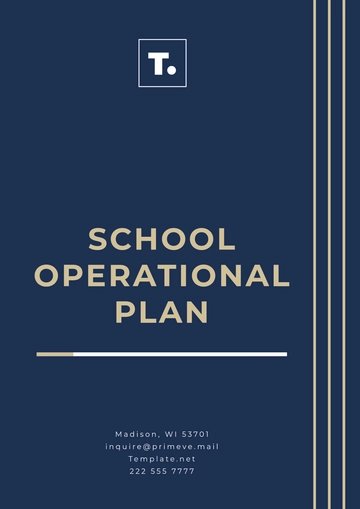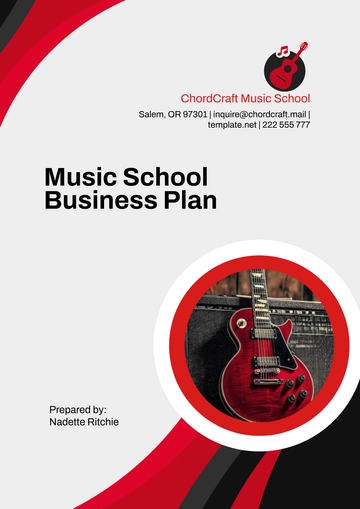Free Education Services Business Plan Layout

1. Executive Summary
Company Name: [Your company name]
Mission Statement: A brief statement outlining your company's goals, values, and the service you provide.
Business Overview: A brief description of your education services, such as tutoring, test prep, online courses, or school consulting.
Market Opportunity: An explanation of the target market, including the need for your services and growth potential.
Business Objectives: Short-term and long-term goals for the company (e.g., reaching a specific revenue target, expanding to new regions, etc.).
2. Company Description
Industry Overview: Description of the education services industry, trends, and challenges.
Business Structure: Whether you are a sole proprietorship, partnership, LLC, or corporation.
Location: Where your business will operate (physical location or online).
Legal Structure: How your business is organized legally.
Vision Statement: A broad, long-term goal for the company.
3. Services Offered
Primary Services: Detail the main educational services you provide (e.g., tutoring, consulting, curriculum design, test preparation, educational technology, etc.).
Service Breakdown: Provide specifics on each service, including:
Description
Target Audience
Delivery Method (online, in-person, hybrid, etc.)
Pricing Model (per session, subscription, packages, etc.)
Competitive Advantages: What sets your services apart from competitors?
4. Market Research
Target Market: Define who your ideal customers are (e.g., high school students, adults looking for career development, corporate clients, etc.).
Market Size & Growth Potential: Use data to estimate the size of the market and its growth rate.
Market Trends: Identify trends in education services (online learning, hybrid models, STEM education, etc.).
Competitive Analysis: Who are your main competitors? What are their strengths and weaknesses? How do you plan to differentiate your business from them?
Customer Personas: Profiles of your ideal customers, detailing their demographics, needs, and pain points.
5. Marketing & Sales Strategy
Branding & Positioning: How will you position your business in the market? What brand image do you want to portray?
Marketing Channels: Which marketing methods will you use (social media, content marketing, search engine optimization, partnerships, paid ads)?
Sales Strategy: How will you sell your services? Will you focus on inbound sales, direct outreach, partnerships with schools, etc.?
Customer Retention: What strategies will you use to keep clients and encourage repeat business (e.g., loyalty programs, feedback loops, referrals)?
Pricing Strategy: Outline how you plan to price your services, and why your pricing model is competitive.
6. Operational Plan
Location & Facilities: If you have a physical office or learning center, describe the location and layout.
Technology: Outline any software, learning management systems (LMS), or tools you will use to deliver services.
Staffing Requirements: Include key roles such as teachers, tutors, administrative staff, customer service, and management.
Suppliers & Partners: Identify any external suppliers or partners you will work with (textbook suppliers, tech partners, etc.).
Customer Support: How will you handle client inquiries, feedback, or concerns?
7. Management & Organization
Team Structure: Organizational chart showing key team members and their roles.
Key Personnel: Include brief biographies of the leadership team, highlighting relevant experience and expertise.
Hiring Plan: Any plans for hiring more staff soon.
8. Financial Plan
Revenue Model: Explain how you plan to generate revenue (e.g., per-session fees, subscription models, or product sales).
Start-up Costs: Outline the capital required to get the business off the ground (e.g., technology, marketing, facility costs).
Profit & Loss Forecast: Projected revenue, expenses, and profit for the next 1–3 years.
Cash Flow Statement: Forecast of monthly cash inflows and outflows.
Break-even Analysis: The point at which your business will become profitable.
Funding Requirements: If you need funding, specify how much and how it will be used.
9. Risk Analysis
Market Risks: What are the potential market-related risks (e.g., changing demand, new competitors)?
Operational Risks: Any risks related to delivering your services (e.g., staffing challenges, technology failures)?
Financial Risks: Risks associated with cash flow, funding, and financial sustainability.
10. Appendices
Additional Supporting Information: Include any relevant charts, graphs, licenses, certifications, contracts, or agreements that can back up your business plan.
Resumes: Provide detailed resumes of the management team.
Legal Documents: Include any necessary legal paperwork for your business.
- 100% Customizable, free editor
- Access 1 Million+ Templates, photo’s & graphics
- Download or share as a template
- Click and replace photos, graphics, text, backgrounds
- Resize, crop, AI write & more
- Access advanced editor
Optimize your strategy with Template.net’s Education Services Business Plan Layout Template. Customizable and editable, it emphasizes goals, services, and funding strategies. Editable in our AI Editor Tool, this template ensures clarity and professionalism. Download it to build your education business.
You may also like
- One Page Business Plan
- Coffee Shop Business Plan
- Restaurant Business Plan
- Food Business Plan
- Real Estate Business Plan
- Executive Summary Business Plan
- Cover Page Business Plan
- Nonprofit Business Plan
- Daycare Business Plan
- Construction Business Plan
- Startup Business Plan
- Medical Business Plan
- Bakery Business Plan
- Service Plan
- Hotel Business Plan
- Catering Business Plan
- School Business Plan
- Healthcare Business Plan
- Transportation Plan
- Sports Plan
- Car Wash Business Plan
- Salon Business Plan
- Clothing Business Plan
- Farming Business Plan
- Boutique Plan





























